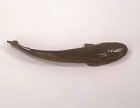Japanese Gallery (Honkan) Room 16
August 28, 2007 (Tue) - October 8, 2007 (Mon)
September 1st is Disaster Prevention Day. This display features historical materials related to disasters during the Edo period, including the eruption of Mt. Asama in 1783 and the Great Edo Earthquake of 1855. These scenes portray the horrors of disaster and remind us of their unpredictability, the need to be prepared, and to take measures that minimize risk.
Among the disasters that occurred during the Edo period, fire was common. Cities consisted of dense areas of wooden houses. In order to prevent fires from spreading, various groups of firefighters were organized by the community, daimyo, and shogunate. Firefighting techniques, however, were rather primitive and mainly consisted of destroying neighboring houses to prevent the fire from spreading. For this reason, the area of destroyed houses was sometimes larger than the burned area.
After the Great Meireki Fire in 1657, the government took greater precautions to prevent fires from spreading, such as setting aside vacant land and building large embankments that fire could not cross. In addition, techniques that would make houses more resistant to earthquakes, lightning, and fire were developed. Furthermore, new technology was invented, such as an instrument to detect earthquakes immediately before they occurred.

